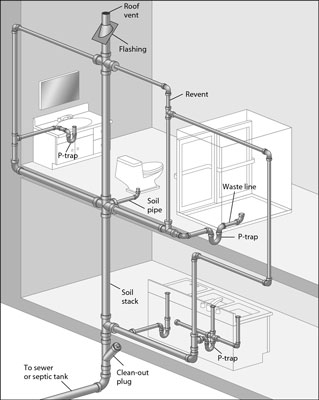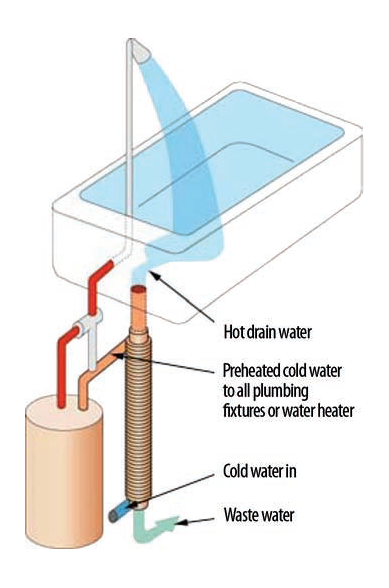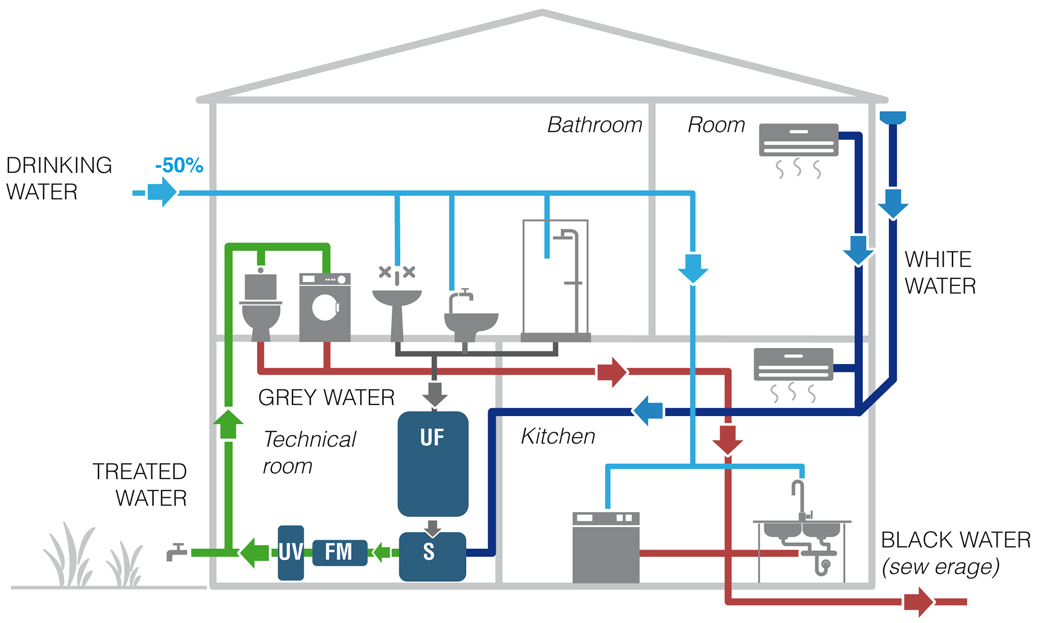Drain, Waste, & Vent Plumbing

As much as 60% of all residential waste water comes from baths, showers, laundry, and the kitchen. Coming up with ways to recover the gray water or heat energy could help with being more green. Depending on your location and source of water, this could be more or less important to you.
Drain water heat recovery

Drain water heat recovery can make sense for people that prefer showers to baths. This is a good way of capturing some of the heat in waste water that would otherwise be lost. As much as 90% of the energy used to heat water goes down the drain with it. Drain-water heat-recovery devices are simple to install and cost-effective. Studies have determined potential savings of between 15-30% in energy required to heat water resulting from the installation of a drain-water heat recovery device.
Drain-water heat recovery devices are usually 4 to 6 feet long, and must be installed vertically. They can’t be installed in a single-story home with a slab foundation, but they work well in a two-story home with upstairs bathrooms or in any home with a basement.
- Storage systems. These incorporate a dedicated storage tank. Water from the drain goes through a heat exchanger inside the tank, warming the stored water. A second heat exchanger at the top of the tank preheats water on its way to the hot-water heater or to its point of use. Because of the high cost of these systems, they are rarely installed.
- Systems without storage. These systems, which are far more common than storage systems, require the installation of a simple drain-water heat-recovery device (for example, the GFX). The device consists of a length of copper drain pipe, usually 3 in. or 4 in. in diameter and 4 ft. to 6 ft. long, surrounded by a spiraling length of copper supply tubing. Installed vertically, the device heats cold water as it flows to the hot-water heater or the point of use. Non-storage systems are effective only when hot water is going down the drain at the same time that cold water is coming in, such as when someone is taking a shower. The devices will not save energy when installed in houses where occupants prefer baths to showers. Prices for drain-water heat recovery systems range from $300 to $500. Paybacks range from 2.5 to 7 years, depending on how often the system is used.
Gray Water Recovery

Wastewater disposal systems present opportunities for both energy and water conservation. It’s easy to dump all liquid waste down the drain and forget about it, and that’s essentially what many urban homeowners are forced to do. They may not have any practical means of separating different types of wastewater and handling them accordingly, at least in existing construction. But rural homeowners can find ways to get a second use out of some wastewater, and they can explore alternatives to conventional waste treatment.
There are two kinds of liquid waste:
- Black water is wastewater from toilets. Because of its bacterial content and the obvious risk of illness, black water must be handled in strict compliance with plumbing codes.
- Gray water — the water we’ve used to brush our teeth, wash our clothes, and fill the bathtub — doesn’t pose the same health risks as black water. Where plumbing codes allow, gray water can be used to irrigate gardens, reducing household water consumption. Even if you can’t reuse your home’s gray water, a heat-recovery device can be installed on a vertical drainpipe to lower your home’s energy bills.
Rainwater Collection
Rainwater collection systems are an obvious way of reducing the strain on public and private water supplies. A simple system consists of a rain barrel filled by a downspout from the roof and used to water the garden and lawn. More complicated systems with large cisterns can supply most of a household’s water needs.